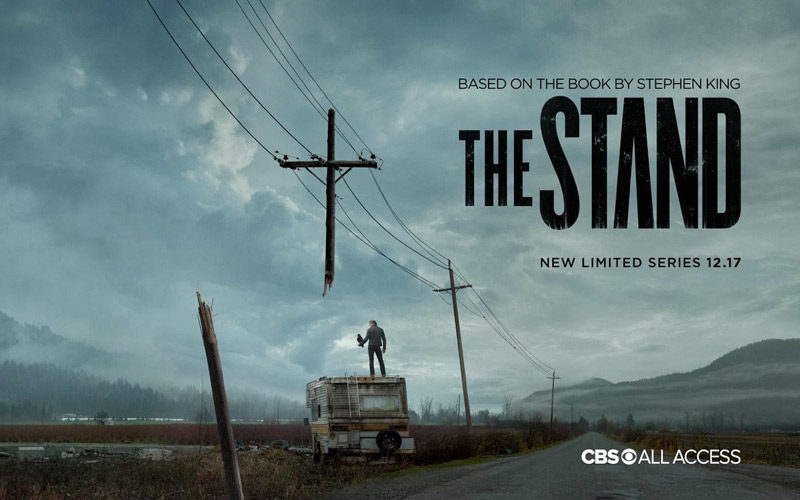‘The Stand’ Miniseries Review: Surface Level Re-Telling of a Masterpiece

The miniseries adaptation of Stephen King’s The Stand, developed by Josh Boone and Benjamin Cavell, is a mixed bag. It tells a dark fantasy post-apocalyptic story centered around the battle between good verse evil.
The nine episodes miniseries could never match the epic nature of the 1308-page non-abridged book. There were shining moments where the creators used media to enhance the story, but most of The Stand feels rushed and only explores the plot’s surface level.
Let’s dive into details. A super influenza pandemic called” Captain Trip” wipes out most of the world’s population. Whoopi Goldberg stars as Mother Abagail, a character whose backstory isn’t developed enough even though Whoopi does a great job at embodying the character.
The novel manages to portray Abagail Freemantle as a fully formed person. In the miniseries, Abigail is simply a messenger of God who tells the council what to do. The best Mother Abagail moments are in the dreams sequences where she speaks to Stu Redman and Frannie Goldsmith. She is this mysterious figure in the wheat fields beckoning them to find their way to Colorado.
Abagail is the child of freed slaves John and Rebecca, who moved to Hemingford Home, Nebraska, for a better life. The Freemantle family built a farm breaking free of their White neighbors’ prejudice. Mother Abagail outlived her parents, siblings, most of her children, and after “Captain Trip,” all of her grandchildren too. She has always been a religious woman who did not update her house with all the new technology. Abigail’s “old-fashioned” home enables it so she can survive on her own for a while. The miniseries is missing all those details.
During a flashback, Nick Andros and Tom Cullen find Mother Abagail in a Nebraskan Nursing Home. This flashback makes it seem like everything is a gift from God and ignores all the hardships this woman has gone through to get here. The audience never feels the full strength of Mother Abagail.
The Stand is told through flashbacks, which is both a detriment and helpful to the miniseries. In early episodes, the flashbacks benefit the show. The first episode,” The End,” starts with Harold Lauder cleaning out the homes of people who died from the flu. A whole crew of people is dumping the corpses of the dead into holes and gathering any items that would be useful to the community. Though in the first few scenes, it’s not clear why all these people are dead. Then there is a flashback scene to five months in the past, which introduces Harold as a teenage outsider with a crush on Frannie. She is a pregnant college student visiting her parents in Maine for spring break.
All the flashback scenes for the first three episodes are used to introduce our protagonists and some antagonists. These scenes are also a way to show how the pandemic spread and why everybody ended up in either Las Vegas, Nevada, or Boulder, Colorado. But the flashbacks sometimes feel like a shortcut to establishing close relationships rather than developing them over time.
For example, developmentally delayed Tom Cullen and deaf Nick Andros’s budding friendship is told through flashbacks. In the first one, Nick finds Tom at the hospital. The two struggle to communicate because Nick doesn’t speak verbally, and Tom cannot read or understand ASL. Thankfully Nick can read lips, and Tom can decipher some of his gestures. The two come together because they both dream of Mother Abigail.
Tom saves Nick’s life in the next flashback when a crazy, sexually charged teenager named Julie aims a gun at his back. Then Nick and Tom are the first people to find Mother Abigail in Nebraska though there is no scene of them traveling to Boulder. The flashbacks show the audience why Nick trusts Tom to go undercover in Las Vegas even with his disabilities, but not how they became so close. The book has pages to show the two men bonding while they traveled alone. If the miniseries were twelve or maybe even fifteen episodes long, it would have given more time to develop the characters and their relationships with one another.
Josh Boone and Benjamin Cavell make some significant improvements to the Nick Andros character. In the novel, The Stand, Nick doesn’t know ASL, so he primarily communicates through writing things down or making simple hand gestures. In the miniseries, he knows ASL. Nick can speak directly to Frannie, who knows sign language. Frannie and Nick are in the counsel in both the book and television miniseries. The fact that she knows ASL is a big coincidence, but they don’t have to rely on somebody reading Nick’s comments to the group. If Nick were continually writing stuff down and somebody reading them aloud, it would not be visually pleasing.
Knowing ASL gives Nick some agency as a deaf person. The second improvement is Nick is a child of illegal immigrants, which explains why he fell through the cracks of the education cracks. In the book, he was raised mostly in the orphanage. Then Nick ran away as a teenager without completing high school and with only an elementary-level education. It is puzzling that nobody taught Nick to sign or gave him a real education. At least as a Latinx young adult with no documentation, it is understandable that Nick is homeless and didn’t go to high school. Sadly, The Stand miniseries did not include aspects of Nick’s culture as part of the story. At times switching the original ethnicity of a character feels forced, but here it is organic.
Fellow Stephen King fans might feel somewhat disappointed by The Stand. If you are into post-apocalyptic stories, read the novel.


Responses